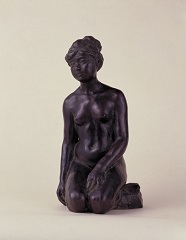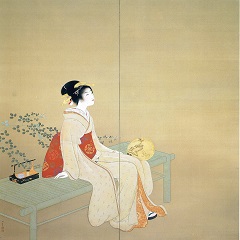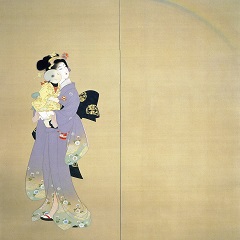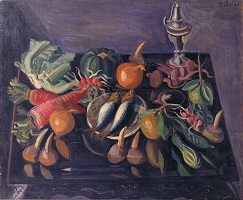Collection GalleryThe 2nd Collection Gallery Exhibition 2013-2014 (125works in all)
Collection Gallery
HOME > Collection Gallery > The 2nd Collection Gallery Exhibition 2013-2014 (127works in all)
The 2nd Collection Gallery Exhibition 2013-2014 (125works in all)
Exhibition Period
2013/07/10 (Wed.)– 2013/09/01 (Sun.)
First: 2013/7/10 (Wed.)– 2013/8/18 (Sun.)
Second: 2013/8/20 (Tue.)– 2013/9/1 (Sun.)
Overview
In commemoration of the 50th anniversary of the museum’s opening, the 2nd Collection Gallery Exhibition of this year features selected masterpieces of both Nihonga and Yoga (Western-style paintings), as well as a display specific to the special exhibition being held on the 3rd floor, entitled "Suzuki Osamu: Images in Clay."
At the entrance to the venue, under the title of【Special Feature 1:The Birth of Sculpture in Japan】, Japanese sculptures from the Meiji to the early Showa periods, and modern French sculptures which exerted a great influence on them are on display. Until the Meiji period, when the Italian sculptor Vincenzo Ragusa came to Japan and taught at Kobu Bijutsu Gakko (Technical Art School) established in Tokyo, "sculpture" in the real western sense of the word did not exist in Japan. Needless to say, historically speaking there were numerous Buddhist statues and ornaments made of wood or metal already in existence in Japan. However, the question of whether or not these works could be called "sculpture" triggered a considerable controversy among such experts as the Japanese sculptor Takamura Kotaro, who had been greatly influenced by western sculptures created by master artists such as Rodin while he was in Europe. For example, Morikawa Toen's White Deer in Kasuga which was acquired by our museum in the 2nd year of its opening and is included in this exhibition, was categorized as a "ornament figurine" by the artist himself and written as such on the surface of its storage box, while in our collection ledger it was registered as a "sculpture." Such circumstances could be said to reflect the aforementioned controversy.

The【Nihonga】section introduces selected masterpieces of artists of Kyoto Art Circle, who played an active role in the prewar government-sponsored Kanten exhibitions such as Bunten (Art Exhibition sponsored by the Ministry of Education) and Teiten (Imperial Academy Art Exhibition). Since they are representative works of art from our collections, we receive numerous loan requests from other museums and therefore have not had the chance to exhibit these precious treasures at our own museum for a long time. Now, we are finally able to display such works as Uemura Shoen's Looking up at a Rainbow, Takeuchi Seiho's Young Ducks and Tsuchida Bakusen's Punishment. As described in the popular Nihonga adage "Taikan in the east, Seiho in the west," Seiho was one of the two top masters of Nihonga at that time. Centering on Seiho's works, we also introduce works of other artists including Taniguchi Kokyo, Tsuji Kako and Kikuchi Hobun who, together with Seiho, were touted as the four most talented pupils in the private art school of Kono Bairei. Works of newly-rising stars in the art world of that time, such as Uemura Shoen, Kikuchi Keigetsu, Nishimura Goun, Domoto Insho, Fukuda Heihachiro and Tokuoka Shinsen, have also been included, which clearly shows the formidable strength and depth of Kyoto Art Circle from the Meiji to the Showa periods.


The【Prints】section features the artwork of Hasegawa Kiyoshi. It focuses not only on Hasegawa's early works such as multicolored woodblock prints, but also on oil paintings and works utilizing techniques such as "Burin," "Aquatint," and "Manière noire," for which he is most famous. The white wall in this section of the building was repainted in gray this spring. The gray wall harmonizes with the somber bronze frames which were selected by Hasegawa himself, as well as with his artwork, creating a tranquil atmosphere.
Correlating to the special exhibition entitled "Suzuki Osamu: Images in Clay," the【Crafts】section features ceramic works by artists who belonged to "Sodei-sha" which Suzuki cooperated to found. The exhibition presents numerous quintessential creations in the pursuit of the expression of ceramic, which would transcend the concept of "beauty within utility." The question whether these works should be considered as an "applied art" based on "utility" or as an independent form of "fine art" ultimately corresponds to the controversy involving "sculpture" described in the【Special Feature 1】section above.
In continuation to our previous exhibition, the【Yoga】section features representative Yoga (Western-style paintings) from around 1925-1935 in our possession. During the Taisho period (1912-1926) many Japanese artists traveled to Europe and USA, confronting the latest trends of arts there. Following their return to Japan, they tried to create a uniquely Japanese style of expression through oil painting that was not an imitation of Western art. Artists such as Totori Eiki and Umehara Ryuzaburo were influenced by Impressionism. Yasui Sotaro was inspired by post-impressionism. Satomi Katsuzo was influenced by fauvism, and Suda Kunitaro was inspired by Spanish paintings. Even though the types of Western art they encountered and confronted were different from one another, all of these Japanese artists were attempting to find an answer to the question of how to connect the Western-style painting with the features and motifs of Japan, and the trial and challenge as they grappled with this problem is clearly reflected in their artwork.

Next, the section entitled【Special Feature 2:Pan-Real Art Association】introduces the innovative trend of Nihonga which appeared at the same time as the founding of "Sodei-sha." The predecessor to "Pan-Real Art Association," the group "Pan-Real" had such members as Suzuki Osamu and Yagi Kazuo, who later left the group to establish "Sodei-sha." As in the case of "Sodei-sha," Nihonga painters who belonged to "Pan-Real Art Association" also bravely tried to transcend the conventional framework of Nihonga expression.
Finally, the【Special Feature 3】section features the exhibition series, "Contemporary Trends of Japanese Art," which we have continually used as a recurring theme. In the fourth exhibition of this series entitled "Contemporary Trends of Japanese Paintings and Sculptures" that opened in 1965, mainly young and mainstay artists in their 30s were selected for display. From their works, guests will be able to grasp the artistic trends of a period when the radical artistic movements of the early 1960s had begun to wane. For more information concerning the【Special Feature 2】and【Special Feature 3】sections, please refer to the explanatory panels displayed at the respective venues.
Themes of Exhibition
- ・Birth of Sculpture in Japan
- ・Commemoration of 50th Anniversry, Selected Masterpieces
Artists of Kanten Exhibitions in the Prewar Kyoto Art Circle - ・Prints and Paintings by Hasegawa Kiyoshi
- ・Regarding the Ceramic Works of Sodeisha
- ・Selected Masterpieces of Japanese Oil Paintings from the Museum Collection II
― Searching for Japanese own Style (around 1925–1935) - ・Panreal Art Group
- ・Reviwe: Exhibition Series
“Contemporary Trend of Japanese Paintings and Sculpture” No. 4 - ・Outdoor sculpture


